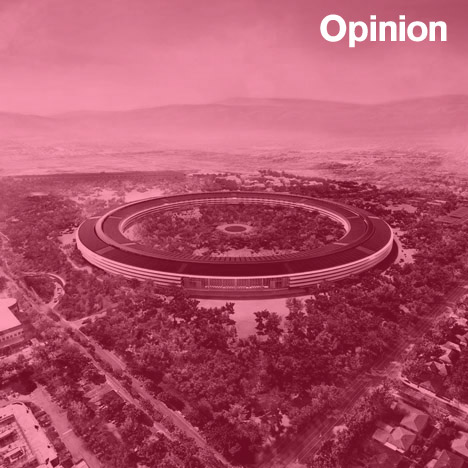
"Cities are being redrawn according to Google's world view"
Opinion: in the second of two columns exploring the impact of digital culture on design, Sam Jacob looks at how Google Maps is reshaping cities while Apple, Facebook and Amazon are reshaping the natural landscape by building their own headquarters as self-contained ecosystems.
The real shape of digital culture does not reveal itself to us in plain sight. In designer and urbanist Dan Hill’s recent essay for the Strelka Press, he neatly describes the substance of what he calls strategic design, which - if you’ll excuse my use of a gigantically broad brush - might be thought of as a welfare-tinged European cousin of North American corporate design thinking.
He calls it dark matter: the stuff that you can’t see that has enormous impact on the way things work and how things happen. For Hill, the dark matter of strategic design might be the complex machinations of healthcare, education and the environment, but for the American National Security Agency it's something far more wide-ranging. How much darker is the matter that the Prism surveillance program deals in?
Prism highlights the very real nature of this digital-system dark matter that's usually hidden from us, though we might feel its vague outline bump against us at moments or see its shadow cast fleetingly across our field of view.
It's there, for example, in the way Google Maps redraws the city in relation to its own way of seeing. Maps, as we know, are a form of information that not only shows us the terrain in question but also reveals the concerns of its author. Maps are not neutral windows onto the world: they colour, frame and distort the world they describe.
Think, for example, of the way alternative forms of mapping projection alter the image of the world and how, seeing the size and balance of continents shift, one's own understanding of the world also shifts. Think too of how a map's point of view is itself a cultural expression - literally a world view. Maps describe the culture that creates them as much as they describe their ostensible subject.
As Slate magazine's Evgeny Morozov explains, Google's business model of targeted advertising is soon to merge with its description of the physical fabric of the city. Using the data that Google already knows about you through your email, your searches and so on, it will generate personalised maps of the city. As Morozov writes, "Space, for Google, is just one more type of information that ought to be organised." And monetised too, we can add. The city, through the map, is remade according to the data held by Google, and according to Google's idea of what a city is and what it thinks you will do there.
Imagine how the experience of Google Glass might alter your experience of the city as it overlays information onto your view, with the city literally becoming framed by Google. This Googleopic way of seeing transforms space and the urban environment through how and what it reveals and excludes. Its ways of seeing, as John Berger’s 1970s book of that title explored, contain hidden ideologies in its visual depiction of landscape. What's relevant here is the way an ideology is made invisible through the manufacturing of images. Increasingly, this frame is used not only to show the world, but to make the world. The map and the territory, in other words, converge.
Over the last year or so, many of the key digital behemoths have unveiled plans for new headquarters: the grand edifices that they choose to erect for themselves. These are the physical ecosystems inhabited by our digital ecosystems, and in these habitats we can read technology companies' own ambitions and their own self images, and perhaps glimpse something of the distortions that digital culture brings to the world around us.
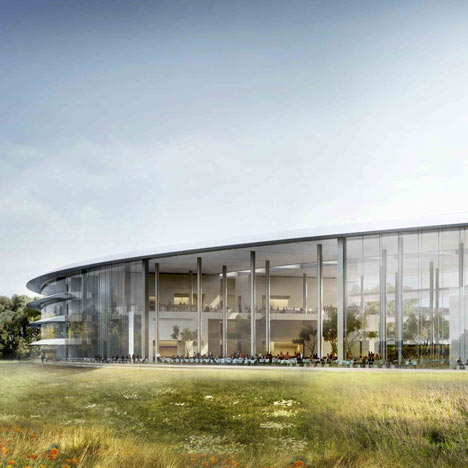
Apple, for example, has long been arrayed in a set of buildings arranged around a road called Infinite Loop. Even here an idea is embedded of how the physical world might be spatially distorted by digital culture: the suburban cul de sac re-read as an endlessly looping piece of computer code.
But having peaked - for the moment at least - as the worlds most valuable company, something more fitting is in store: the Norman Foster-designed Apple City, Cupertino. Arranged as a giant circular plan, the project's renders read like a non-slip, smooth Pentagon, set both in and around a forest. Just like digital space, it’s a form that has no front or back and whose interior is the same as its exterior, resisting traditional urban hierarchies.
Its plan reads as symbolically as anything by nineteenth-century architect Claude Nicolas Ledoux. Its expression is one long zero as though it imagined, despite its 260,100 square metres, that it almost wasn’t there. Apple workers stroll dappled by endless autumn sunlight. This is a particular version of a digital community, accelerated into a perfect hallucinatory cocktail of hyper-tech building and idealised nature.
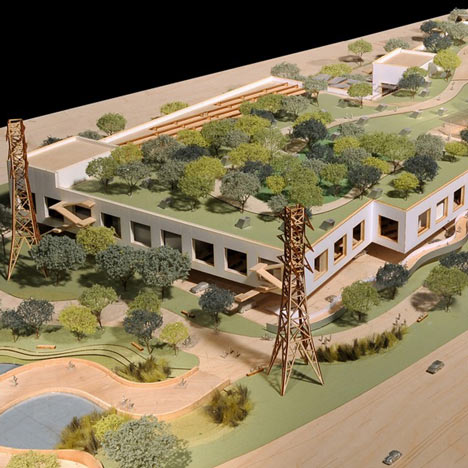
Facebook’s new headquarters in Menlo Park, designed by Frank Gehry, suggests a different relationship to nature. Mark Zuckerberg is quoted as saying: "From the outside it will appear as if you're looking at a hill in nature," but what the hill will actually contain is the largest open-plan office space in the world.
"The idea is to make the perfect engineering space: one giant room that fits thousands of people, all close enough to collaborate together," Zuckerberg said. Perhaps, just like the image of the cloud, the intention is for Facebook to disappear into the landscape, to become invisible and indistinguishable from things as natural as trees, grass and hills.
In designs for both the Apple and Facebook headquarters, the idea of nature is at once highly present and highly synthetic. It's a level constructed above vast parking garages, quoted as experience and presented as mission statement. In both, there are echoes of the hippy pastoral techno-utopias of the 1960s, washed together with management theory and marketing. These are ideologies made glass and grass.
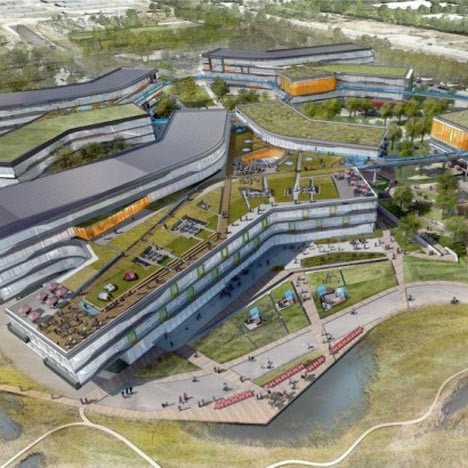
Google’s Bay View campus for California, designed by NBBJ, will be its first North American new-build. Though its appearance is closer to an average business park, it too has its roofs littered with green stuff.
The generic building forms, though, are distorted by what Google knows about: the acquisition of data about human behavior. The buildings are thus twisted and bent by patterns of work, desires and adjacencies, as though the data harvesting of Google Maps were able to warp the world into other organisations. They claim that employees across the 102,200 square-metre development will never be more than two-and-a-half-minutes from one another, creating a kind of hyperlinked organisation.
Proximity and loss of hierarchy are, in this headquarters, core issues. These reflect both the nature of digital work culture and the nature of the digital too. The absence of distance and constant adjacency is at once both the liberation that digital culture brings and the springboard for loss of liberty that Prism suggests. In architectural terms, we might understand this problem in terms of openness: the open plan and the curtain wall are simultaneously things that give us spatial transparency and a condition of panoptic surveillance.
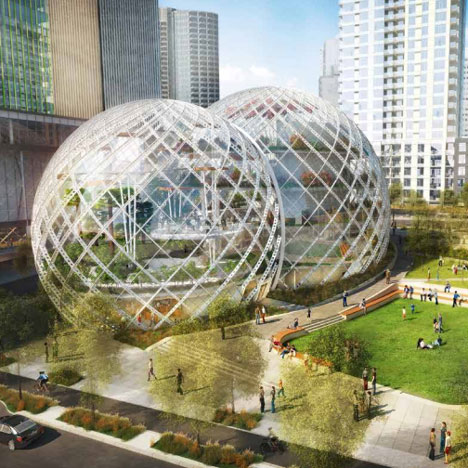
Plans have just been unveiled for Amazon’s new Seattle headquarters, also by NBBJ, that includes a trio of 6039 square-metre biospeheres. Each sphere is conceived as "a plant-rich environment that has many positive qualities that are not often found in a typical office setting." Within these bubble micro-climates will be floors of offices, shops, lounges and canteens - essentially total environments.
Of course Amazon itself is named for an environment, a habitat with geographic scale and significance in arguments of climate change. That the company should actually become a habitat itself, a technologically induced artificial ecosystem, is perhaps a fulfillment of this baby boom radical-to-corporate digital trajectory.
We might trace the roots of these places just as we might trace the origins of the Californian ideology. In part, they are university campuses, the sites of innovation research out of which some of these corporations and their culture spring. In part, too, they emerge out of the hybrid offshoot of architectural design that spliced management consultancy with spatial design.
They also owe much to those intentional communities that bloomed in the 1960s and 1970s: the communes pioneered by hippy culture. Places like Drop City struck out as techno-rural settlements, abandoning the city in favour of Buckminster Fuller-esque geodesic inhabitation of the wilderness. They were ideologically driven as spaces apart from the rest of society where alternatives for ownership, family, energy use, materials and so on could be explored.
They created their own ecosystems, if you will: self-sufficient as sci-fi space ships, supplied by the Whole Earth Catalogue, the hippy version of the Sears and Roebuck catalogue that architectural critic Reyner Banham argued had made the west habitable through mail-order delivery of gadgets and devices in his 1965 essay The Great Gizmo. It’s worth bearing Banham's thesis in mind: if, as he argued, the colonisation of the West was made possible by the gadget, then maybe the gadgets the West now produces are not only a product of some kind of fatalism written into its own origin myths, but the gadgets they now produce are devices of colonisation themselves.
Biosphere 2 was perhaps the largest and most ambitious offshoots of these colonies. Conceived as an ecological experiment, it was a closed system housed in a giant pyramidal greenhouse. Its mission was in part determined by a hippy-science group called the Institute of Ecotechnics, whose mission remains "to establish and develop the new discipline of Ecotechnics, which deals with the relationships between ethnosphere, technosphere and the biosphere" and "which intends to harmonise ecology and technology." It was named Biosphere 2, of course, because Earth is conceived in this way of thinking as Biosphere 1.
The gigantic corporatised versions of these idealised hippy communities also separate themselves from society. These too are idealised spaces, techno-utopias that turn their back on the world that surrounds them in order to manufacture spaces that can sustain their own ideologies. Just as the biosphere is an introverted ecosystem, we see a similar kind of disconnection, a resistance to the idea of the urban. Each becomes its own world, a place that operates according to its own set of rules and ideas, each wrapped up in its own vision of nature.
These are the citadels of the Californian ideology, places where the digital distortions of traditional urban, architectural and environmental space are manifested, places manufactured by processes of design thinking, holistic and totalised within their own limits.
Perfected and protected as these digital epicentres are, it is the rest of the world that feels the effects of the digital reorganisation of space far more profoundly. Outside the limits of these palaces is where the darkest machinations of digitality really work. Even nature itself, its clouds, hills, forests and rivers, traditionally figured as a place of escape and solitude, has long colonised by the digital. To escape its presence might now be almost impossible and might involve the most extreme schemes.
Think, for example, of WikiLeaks founder Julian Assange holed up in the Ecuadorian embassy in west London, or of Edward Snowden, the Prism whistleblower currently in his Hong Kong hotel. Both are now in exceptional spaces, holes in the continuum of globalised digital space. These strange anomalies are perhaps the only escapes from the ever-present digital backdoor, the only respite from the colonisation of earth by digital culture.
In his previous column, Jacob argued that the American National Security Agency's Prism surveillance program was something born not only out of the networked world we now inhabit, not only out of our reliance on a small group of Californian companies who may well have cooperated with the intelligence services, but out of a way of thinking that characterises those very same companies: design thinking.
Read part one »
See all stories about technology companies »
Sam Jacob is a director of architecture practice FAT, professor of architecture at University of Illinois Chicago and director of Night School at the Architectural Association School of Architecture, as well as editing www.strangeharvest.com.